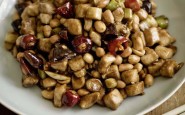Fried noodles or chow mein
After chop suey, chow mein (which means ‘fried noodles’) must be the next most popular Chinese dish among Westerners apart, perhaps, from sweet and sour pork. Curiously enough, although noodle dishes are widely eaten in China, the famous ‘crispy noodles’ served in some Chinese restaurants abroad are just as alien to the Chinese as chop suey. How this came about is a complete mystery to me.
However, fried noodles can be very good when properly cooked. They are very quick and simple, and call for no special ingredients once you have got the basics. As with the ‘ten varieties’ dishes, you could use almost any leftovers to improve the flavour and texture.
1/2 lb (225 g) egg noodles or spaghetti
1/2 lb (225 g) meat (pork, beef or chicken)
1 tsp salt
1/2 tsp sugar
1 tsp cornflour
1/4 lb (100 g) bamboo shoots
1/4 lb (100 g) leaf spinach (or young greens)
4 tbsp oil
1 tbsp light soy sauce
1 tbsp rice wine or sherry
1-2 spring onions, thinly shredded
a few drops sesame seed oil
Method
If you cannot get Chinese noodles, then use spaghetti (or the finer spaghettini) or noodles, tagliatelle or vermicelli. Allow at least 2 oz (50 g) per person. If you are lucky enough to live near an Oriental foodstore or Italian delicatessen, you may be able to get freshly made noodles which taste far better, cooked, than the dried variety.
First, shred the meat into small, thin strips and mix in a pinch each of salt, sugar and cornflour. Then shred the bamboo shoots into thin strips. Wash the spinach leaves or greens and cut them into shreds too. Now cook the noodles in boiling water according to the instructions on the packet. (Normally this would take about 5 minutes, but freshly made noodles will take only 2 minutes or less). Be careful not to overcook them, or they will become soggy. Drain the noodles and rinse in cold water, then drain again.
Heat about 2 tablespoons oil in a hot wok, stir-fry the meat and vegetable together with salt for about 1 1/2 minutes, add the wine and a little cornflour mixed with cold water to thicken the sauce. Remove and set aside to be used as ‘dressing’.
Heat the remaining oil until smoking, add the noodles and spring onions, stir like mad to separate them, then add soy sauce and about half of the ‘dressing’. Continue stirring for another 1/2 minute or so, then serve with the remaining ‘dressing’ on top and garnished with sesame seed oil.
This is a basic recipe for chow mein, and it never fails to please eager eaters, big and small – it is a firm favourite with both my daughters and their friends. Of course you can substitute any of the ingredients as you like: for instance, the meast could be beef, ham, chicken or prawns; the vegetables could be cabbage, lettuce, cucumber, green beans, mange-touts peas, broccoli or asparagus. The thing to remember here is the contrast of texture and colour.
Strictly speaking, you are not supposed to serve this dish as a main meal, and definitely not at the same time as rice – just as you would not serve potatoes and spaghetti together. Noodle dishes in China are normally served in between meals as a snack. Traditionally, though, they are always served at birthday celebrations, partly because the length of noodles represents long life to a Chinese mind.
© Deh-Ta Hsiung and reproduced with his kind permission.


